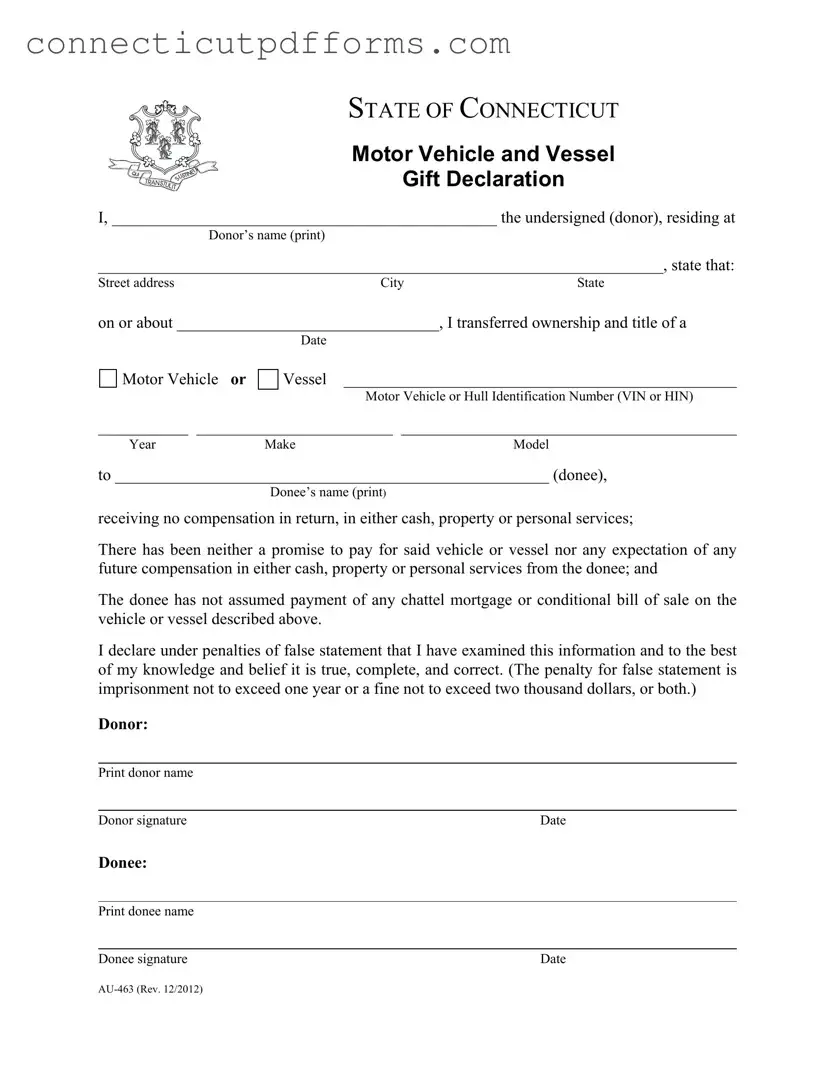The Connecticut Au 463 form serves as a declaration for the gift of a motor vehicle or vessel. A similar document is the Bill of Sale. This document is often used in transactions where ownership of a vehicle is transferred. Unlike the Au 463 form, which emphasizes that no compensation was received, the Bill of Sale can reflect a sale or trade. It provides proof of purchase and details the terms of the transaction, ensuring that both parties are aware of their rights and responsibilities.
Another comparable document is the Title Transfer Application. This form is necessary when ownership of a vehicle is officially changed in the state's motor vehicle department. While the Au 463 form focuses on gifts, the Title Transfer Application is used in both sales and gifts. It requires similar information about the vehicle and the parties involved, ensuring that the state records reflect the current ownership accurately.
The Affidavit of Gift is also related to the Au 463 form. This document serves as a sworn statement that a vehicle has been given as a gift. It may be required by some states to accompany the title transfer process. Like the Au 463, it confirms that no payment was made for the vehicle. However, it often includes additional legal language and may require notarization to verify the authenticity of the donor's claim.
The Vehicle Donation Receipt is another document that shares similarities with the Au 463 form. This receipt is typically issued when a vehicle is donated to a charitable organization. It serves as proof of the donation for tax purposes. While the Au 463 focuses on personal gifts, the Vehicle Donation Receipt emphasizes the charitable aspect and may include the organization's tax identification number for the donor's records.
The Gift Tax Return (Form 709) is also relevant. This IRS form is used to report gifts that exceed a certain monetary threshold. While the Au 463 form is state-specific and does not involve taxes, it is important for donors to understand their federal tax obligations when giving a vehicle. The Gift Tax Return ensures that any potential tax liabilities are reported and managed appropriately.
In understanding the various documents involved in the transfer of vehicle ownership, it is equally important to consider the specific requirements and implications of each form, such as the Templates and Guide that assists in ensuring compliance with state regulations, especially for motorcycle transactions in New York.
The Power of Attorney for Vehicle Transactions can be considered similar as well. This document allows one person to act on behalf of another in matters related to vehicle ownership. If a donor cannot be present to complete the Au 463 form or other transfer documents, they may grant power of attorney to someone else. This ensures that the gift can still be processed legally and efficiently.
Lastly, the Vehicle Registration Application may also be compared to the Au 463 form. When a vehicle is gifted, the new owner must register it in their name. This application collects information about the vehicle and the new owner, similar to the Au 463. While the focus of the Au 463 is on the gift itself, the Vehicle Registration Application ensures that the vehicle is legally registered under the new owner's name.

